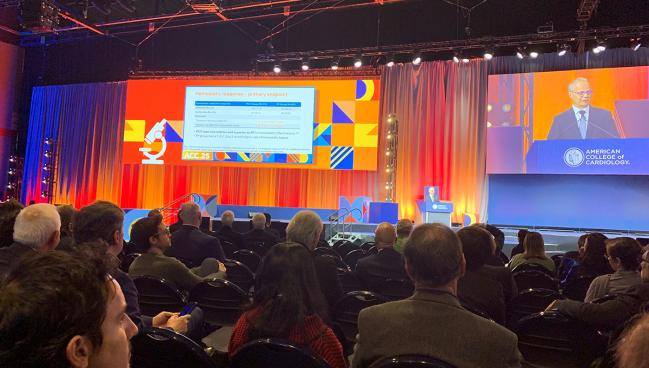Shelf-stable Product May Sub in for Frozen Plasma in Cardiac Surgery: FARES-II
The prothrombin complex concentrate costs more than plasma, but may pay dividends by way of fewer adverse events.

CHICAGO, IL—A shelf-stable blood product may be a reasonable alternative to frozen plasma in cardiac surgery patients who experience bleeding, the FARES-II trial suggests.
The four-factor prothrombin complex concentrate (PCC) was noninferior to frozen plasma for hemostatic response and superior for hemostatic efficacy, researchers reported, with no accompanying increase in thrombotic events across a range of patients undergoing surgery with cardiopulmonary bypass.
“Whenever you use a hemostatic agent, you're worried about safety,” Keyvan Karkouti, MD (Toronto General Hospital, Canada), said in a press conference prior to his presentation here on Saturday at the American College of Cardiology (ACC) 2025 Scientific Session.
”We found not only did it not increase thrombotic adverse events, it actually reduced some of the adverse events we were looking at, including serious adverse events, which were reduced by 24%,” he said, adding that it also halved acute kidney injury.
PCCs are derived from plasma and are purified, and they contain concentrated doses of factors II, VII, IX, and X. They are shelf-stable and can be given to any patient without need for blood typing. The hypothesis for the trial was that by stopping bleeding early and reducing need for transfusions, the plasma substitute would lower the associated risk of adverse events.
With as many as 30% of cardiac surgery patients potentially having bleeding that requires transfusion, using a PCC could reduce patient exposure to allogeneic blood products and ease pressure on hospital blood supplies, say researchers.
In a simultaneous publication of the results in JAMA, Karkouti and colleagues note that patients who received the PCC used about 95% fewer frozen plasma units than the control group. In the US alone, this could save around 350,000 units of frozen plasma that could be “redirected to help address supply challenges in plasma-derived medicinal products,” they write.
It's important that institutions not get siloed in cost of the agent alone, but also look at what the total cost of care is for these patients. Toby Trujillo
Speaking in the press conference, Toby Trujillo, PharmD (University of Colorado Anschutz Medical Campus, Aurora), said he expects the FARES-II findings will “help support the use of PCCs as a standard of care in cardiac surgery when needed to help stem bleeding when it's happening.”
However, the substitute’s cost relative to donated frozen plasma is a significant issue. He said the amount used per patient in FARES-II (about 24 IU/kg) would vary by institution but estimated it would likely run several thousand dollars. It’s possible PCCs could balance out other costs down the line.
“It's important that institutions not get siloed in cost of the agent alone, but also look at what the total cost of care is for these patients,” he told TCTMD. “We need more data, but my suspicion is that the total cost of care will be less with PCCs as compared to just giving plasma because of the reductions in things like kidney injury that you saw in this trial.”
FARES-II Results
The multicenter trial randomized 420 patients (median age 66 years; 26% women) at 12 hospitals in Canada and the US who developed bleeding related to coagulation factor deficiency after cardiopulmonary bypass during surgery. Randomization to PCC or frozen plasma occurred in the operating room. Approximately half of procedures in each group involved the aortic valve.
Hemostatic effectiveness was seen in 78% of the PCC group and 60.4% of the frozen plasma group (P < 0.001 for noninferiority and superiority). Overall, the group receiving frozen plasma had a 1.8-fold greater rate of hemostatic failure. The results were consistent across subgroups, including sex, age, complexity of surgery, and duration of the procedure.
In the subsequent 24 hours, 45.5% of patients in the PCC group and 63.8% in the frozen plasma group received red blood cell transfusions. Instances of severe or massive bleeding and the cumulative number of allogeneic blood product transfusions given were lower for the PCC group.
The rate of serious adverse events was lower in the PCC group at 36.2%, compared with 47.3% in the frozen plasma group (RR 0.76; 95% CI 0.61-0.96). Similarly, the rates of acute kidney injury were 10.3% and 18.8%, respectively (RR 0.55; 95% CI 0.34-0.89).
In an editorial accompanying the paper in the journal, Ryan Wang, MD (Icahn School of Medicine at Mount Sinai, New York, NY), and Elliott Bennett-Guerrero, MD (Renaissance School of Medicine at Stony Brook University, NY), point out that the most significant clinical benefit of PCCs “is their ability to more rapidly restore factor levels because their small dosing volume allows for more rapid administration.”
But, the positive findings of FARES-II are in contrast to two other trials of PCCs that did not see a difference in 24-hour transfusion requirements compared with patients receiving frozen plasma. “The superior hemostatic effect observed in the FARES-II trial is potentially explained by the larger sample size, and most likely, the use of higher doses of PCC (24 IU/kg) vs dosing used in previous trials (15 IU/kg6 and 13 IU/kg7),” they write.
Wang and Bennett-Guerrero also say PCCs may be of particular benefit in coagulopathic patients, such as euvolemic patients or those with significant right ventricular dysfunction, who cannot receive a large volume of thawed frozen plasma.
Commenting in the session here, Mario Gaudino, MD, PhD (Weill Cornell Medicine, New York, NY), stressed that longer follow-up will be needed, particularly in those who receive PCCs after CABG since graft thrombosis can be silent in the first months after surgery. It will be important, he said, to know if a PCC increases the risk in relation to frozen plasma.
L.A. McKeown is a Senior Medical Journalist for TCTMD, the Section Editor of CV Team Forum, and Senior Medical…
Read Full BioSources
Karkouti K, Callum JL, Bartoszko J, et al. Prothrombin complex concentrate vs frozen plasma for coagulopathic bleeding in cardiac surgery the FARES-II multicenter randomized clinical trial. JAMA. 2025;Epub ahead of print.
Wang R, Bennett-Guerrero E. Is it time to replace plasma with prothrombin complex concentrate in cardiac surgery? JAMA. 2025;Epub ahead of print.
Disclosures
- The trial was supported with funding from Octapharma AG and the Canadian Institutes of Health Research.
- Karkouti reports receiving personal fees from Octapharma-Werfen outside the submitted work.





Comments